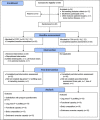Recreational Football Training Increases Leg-Extensor Velocity Production in 55- To 70-Year Old Adults: A Randomized Controlled Trial
- PMID: 37293410
- PMCID: PMC10244983
- DOI: 10.52082/jssm.2023.345
Recreational Football Training Increases Leg-Extensor Velocity Production in 55- To 70-Year Old Adults: A Randomized Controlled Trial
Abstract
This study investigated the effects of 10 weeks of recreational football training on the leg-extensor force-velocity (F-V) profile in 55- to 70-year-old adults. Simultaneous effects on functional capacity, body composition and endurance exercise capacity were examined. Forty participants (age 63.5 ± 3.9 years; 36♂ 4♀) were randomized in a football training (FOOT, n = 20) and a control (CON, n = 20) group. FOOT performed 45-min to 1-h of football training sessions with small-sided games twice a week. Pre- and post-intervention assessments were performed. The results revealed a greater increase in maximal velocity (d = 0.62, pint = 0.043) in FOOT compared to CON. No interaction effects were found for maximal power and force (pint > 0.05). 10-m fast walk improved more (d = 1.39, pint < 0.001), 3-step stair ascent power (d = 0.73, pint = 0.053) and body fat percentage (d = 0.61, pint = 0.083) tended to improve more in FOOT than in CON. RPE and HR values at the highest speed level during a submaximal graded treadmill test decreased more in FOOT compared to CON (RPE: d = 0.96, pint = 0.005; HR: d = 1.07, pint = 0.004). Both the number of accelerations and decelerations as well as the distance spent in moderate- and high-speed zones increased markedly throughout the 10-week period (p < 0.05). Participants perceived the sessions as very enjoyable and feasible. In conclusion, recreational football training resulted in improved leg-extensor velocity production, which translated to a better performance on functional capacity tests that rely on a high execution velocity. Simultaneously, exercise tolerance was improved and body fat percentage tended to reduce. It appears that short-term recreational football training can induce broad-spectrum health benefits in 55- to 70-year-old adults with only 2 hours of training per week.
Keywords: Small-sided games; force-velocity profile; functional capacity; muscle power; soccer; training load.
© Journal of Sports Science and Medicine.
Figures




References
-
- Alcazar J., Rodriguez-Lopez C., Ara I., Alfaro-Acha A., Manas-Bote A., Guadalupe-Grau A., Garcia-Garcia F.J., Alegre L.M. (2017) The Force-Velocity Relationship in Older People: Reliability and Validity of a Systematic Procedure. International Journal of Sports Medicine 38, 1097-1104. https://doi.org/10.1055/s-0043-119880. 10.1055/s-0043-119880 - DOI - PubMed
-
- Alcazar J., Rodriguez-Lopez C., Delecluse C., Thomis M., Van Roie E. (2023) Ten-year longitudinal changes in muscle power, force, and velocity in young, middle-aged, and older adults. Journal of Cachexia, Sarcopenia and Muscle 14(2), 1019-1032. https://doi.org/10.1002/jcsm.13184. 10.1002/jcsm.13184 - DOI - PMC - PubMed
-
- Andersen T.R., Schmidt J.F., Nielsen J.J., Randers M.B., Sundstrup E., Jakobsen M.D., Andersen L.L., Suetta C., Aagaard P., Bangsbo J., Krustrup P. (2014) Effect of football or strength training on functional ability and physical performance in untrained old men. Scandinavian Journal of Medicine & Science in Sports 24 Suppl 1, 76-85. https://doi.org/10.1111/sms.12245. 10.1111/sms.12245 - DOI - PubMed
-
- Bangsbo J., Hansen P.R., Dvorak J., Krustrup P. (2015) Recreational football for disease prevention and treatment in untrained men: a narrative review examining cardiovascular health, lipid profile, body composition, muscle strength and functional capacity. British Journal of Sports Medicine 49, 568-576. https://doi.org/10.1136/bjsports-2015-094781. 10.1136/bjsports-2015-094781 - DOI - PMC - PubMed
-
- Beato M., Jamil M., Devereux G. (2018) Reliability of internal and external load parameters in recreational football (soccer) for health. Research in Sports Medicine 26, 244-250. https://doi.org/10.1080/15438627.2018.1431532. 10.1080/15438627.2018.1431532 - DOI - PubMed
Publication types
MeSH terms
LinkOut - more resources
Full Text Sources
